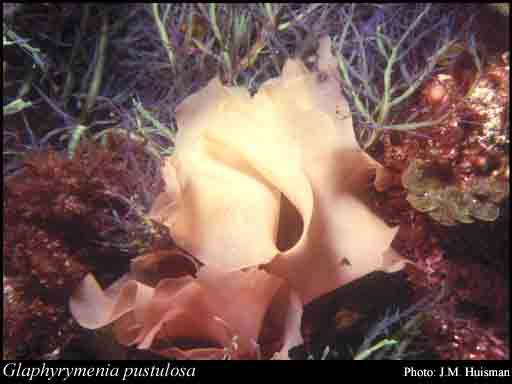- Reference
- Acta Univ.Lund. 53-54, pl 1, fig 4 (1885)
- Conservation Code
- Not threatened
- Naturalised Status
- Native to Western Australia
- Name Status
- Current

Scientific Description
Habit and structure. Thallus pale rose-red to medium red, foliose, 10–60 cm high and usually broader than high, blade rounded when young and often becoming irregularly lobed or sometimes laciniate, with a smooth to markedly undulate margin which may be slightly dentate; substance gelatinous and firm when living, adhering strongly to paper on drying and disintegrating fairly quickly on wetting. Holdfast discoid, 1–2 mm across; epilithic. Structure. Thallus 300–700(–1000) µm thick, filamentous throughout with a loose network of medullary filaments 3–5 µm in diameter, and a dense cortex of similar branched filaments becoming anticlinal, with short chains of ovoid outer cortical cells, each 2–3 µm across; small, lightly staining stellate cells present in the medulla.
Reproduction. Sexual thalli dioecious. Carpogonial branch systems formed from inner cortical filaments, mono- or bicarpogonial, with a rounded supporting cell producing 2–4 subspherical subsidiary cells, 1 or 2 of which develop into normally 3-celled carpogonial branches. Fusion cell lobed but relatively simple, producing several connecting filaments. Auxiliary cell systems 30–45 µm across, the auxiliary cell bearing 3–4 subsidiary cells. Cystocarps scattered over most of the thallus, 220–600 µm across, embedded in the thallus but protruding somewhat when fully developed, consisting of a central mass of slender gonimoblast filaments producing outwardly numerous subspherical carposporangia each 14–20 µm across and mostly not intermixed with gonimoblast filaments; a loose surrounding involucre of filaments present. Male thalli with minute spermatangia (about 1 µm in diameter) cut off from the outer cortical cells. Tetrasporangia scattered in the cortex, ovoid, 16–22 µm long by 12–15 µm broad, cruciately divided.
Distribution.New Zealand. Waldegrave I., S. Aust., to Port Phillip, Vic., and SE Tas; known from depths of 3–22 m.
[After Womersley, Mar. Benthic Fl. Southern Australia IIIA: 240 (1994)]
Distribution
- IBRA Regions
- Swan Coastal Plain.
- IBRA Subregions
- Perth.
- IMCRA Regions
- Abrolhos Islands, Leeuwin-Naturaliste.
- Local Government Areas (LGAs)
- Cockburn, Greater Geraldton, Joondalup.